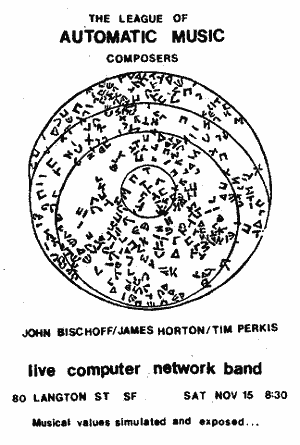This article documents the work of two bands that were active in the San Francisco Bay Area between the mid-1970s and late 1990s. The League of Automatic Music Composers and The Hub were two of the first ensembles to investigate the unique potentials of computer networks as a medium for musical composition and performance. Both groups came about as associations of computer music composers who were also designers and builders of their own hardware and software instruments. Their approach to the computer music medium was strongly do-it-yourself, a characteristic common both to the electronic technology community of the San Francisco Bay Area, and the experimental instrument-building tradition of Harry Partch, John Cage, and David Tudor. They approached the computer network as a large, interactive musical instrument in which the data-flow architecture linked independently programmed automatic music machines, producing a music that was noisy, surprising, often unpredictable, and was definitely more than the sum of its parts.
Co-written by two members of the Hub, this article provides an audio/visual tour of the music, instruments, and networking designs produced by these bands. In assembling together the sounds, still images, video, programs, and diagrams that are the artifacts of twenty-odd years of creative work, we are struck by the ways in which both the recording and performance technologies represented reflect the character of their times. But we also hope to point out how many of the issues that were confronted by these bands are still relevant today to composers working on ways to make the internet a medium for live, interactive musical performance. This article will be followed in August 2002 on this same Crossfade site by the premiere of two new online network music pieces, one by each of us, pointing in that direction.
Introduction: Experimental Music in the Bay Area
 |
|
League concert flyer, designed by Tim Perkis, from Nov. 15, 1980 featuring image of cabalistic alphabet |
In the 1970s and 80s, the San Francisco Bay Area was fertile ground for composers experimenting with microcomputers as musical instrument automata. For musicians of that time and place it was but a small step from the practice of acoustic music realized by the rigorous application of algorithms, including chance (Cage), stochastic (Xenakis), or minimalist processes (Reich), to the application of similar methods by machines in live electronic music. As yet unnamed, the Silicon Valley was springing to life from the garages and bedrooms where the potentials of solid-state electronic devices as building blocks for information systems could be investigated by individuals working in the shadows of the mainframe-dominated electronic industry. With the flowering personal computer industry in the Bay Area, access to the new digital technologies and to the people who developed them was perhaps the best in the world. But for all the young men with fortunes in the back of their minds (and in their futures) who pursued the addictive excitement of building electronic machines, there were also the political utopians whose dream was of a new society built on the free and open access to information, and on a comprehensively designed technology based on embedded intelligence.
This was also the culture that gave the world "New Age" music,
a watered-down and commercialized version of the musics based on modes
and drones that Terry Riley, Pauline Oliveros, and LaMonte Young invented
here during the late fifties and early sixties. But West Coast music-making
also included a free-wheeling, noisy, improvisational edge left over from
the counter-cultural revolutions of the sixties. Defiantly non-commercial,
and practiced by musicians coming from classical, free jazz, or experimental
rock backgrounds, its aesthetic preferred compositions that changed with
each performance, textures that emphasized a simultaneous multiplicity
of voices, and a practice based on collaborative, communal or group-oriented
activities. Another ingredient in this musical stew was the influence
of the West Coast tradition of composer as instrument builder (Harry Partch,
Lou Harrison, and John Cage) which emphasized taking control of the means
of making music itself, including the tuning systems and the instruments.
Why NOT extend this approach to the new electronic technologies? Finally,
the lack of significant opportunities on the West Coast for the support
and presentation of art music made composers in the Bay Area more likely
to embrace underground, experimental aesthetics. Since the audience was
so unfocused, and opportunities for careerism so futile, why not spend
one's efforts following the potential of fantastic ideas, rather than
worrying about the practical applications of those ideas within traditional
musical domains?